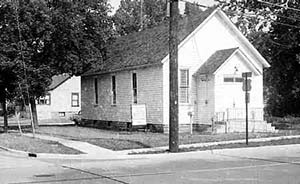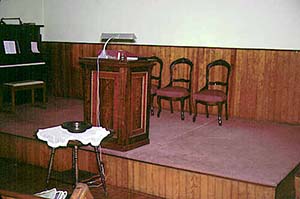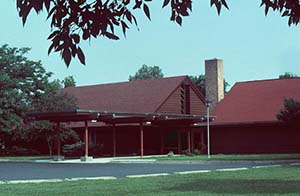Midland Adventist History
The year was 1911. Freelance Seventh-day Adventist evangelist I. H. Evans, had come to Midland to conduct a series of meetings. Perhaps providentially he found an old country school house four miles west of Midland available for use. There, on what is now Homer road, he presented the message. The Holy Spirit's work was evident and nearly a dozen families were baptized and formed a small church. Initially the group met for services in members' homes. Sadly their numbers rapidly dwindled to a low of eight persons, most of them members of the Windover and Rider families.
 The
group continued meeting, opting after a few months to conduct church
services in the City Library Building which stood at the corner of
Ellsworth and Ashman Streets. The church was officially
organized as The Midland Church of Seventh-day Adventists with three
charter members, and 14 additional members on February 28, 1915.
Less than a year after organizing as a church, the congregation
decided to build a church building of their own. A lot donated by the
city at the corner of Eastman Avenue and Hines Street (where Indian
Street joins Eastman) was the site chosen. The small group donated the
funds, purchased materials, and began construction. After three years
of work the construction was completed. A debt of $300 was paid off
and the church was dedicated in 1917. The fourteen individuals,
including six charter members rejoiced in their new house of worship.
The
group continued meeting, opting after a few months to conduct church
services in the City Library Building which stood at the corner of
Ellsworth and Ashman Streets. The church was officially
organized as The Midland Church of Seventh-day Adventists with three
charter members, and 14 additional members on February 28, 1915.
Less than a year after organizing as a church, the congregation
decided to build a church building of their own. A lot donated by the
city at the corner of Eastman Avenue and Hines Street (where Indian
Street joins Eastman) was the site chosen. The small group donated the
funds, purchased materials, and began construction. After three years
of work the construction was completed. A debt of $300 was paid off
and the church was dedicated in 1917. The fourteen individuals,
including six charter members rejoiced in their new house of worship.
By today's standards it was small and plain. But it was "church" for Midland Adventists for 50+ years, including many who remain members of our congregation to the present. Interior walls were painted plaster. The glass in the windows was wavy. Varnished wainscot paneling was the only decoration in the sanctuary.
 As
originally constructed the church was a single room, 24 by 40
feet. On a platform at the end opposite the entrance stood a
donated upright piano, the handmade pulpit, and three ornate chairs. A
small table was placed in front of the pulpit for use in communion
services and to hold the bouquets of flowers frequently brought by
worshippers. To the right of the platform, space was provided
for a wood burning stove. Also in this area, a small round table
was the place for children's Sabbath School. The eight rows of
oak pews, purchased form the Presbyterian Church, seated about sixty
people.
As
originally constructed the church was a single room, 24 by 40
feet. On a platform at the end opposite the entrance stood a
donated upright piano, the handmade pulpit, and three ornate chairs. A
small table was placed in front of the pulpit for use in communion
services and to hold the bouquets of flowers frequently brought by
worshippers. To the right of the platform, space was provided
for a wood burning stove. Also in this area, a small round table
was the place for children's Sabbath School. The eight rows of
oak pews, purchased form the Presbyterian Church, seated about sixty
people.
During the 1930's several improvements were made. A large 45" coal burning furnace, donated by the Dow family (good friends of church member John Buschlein) was installed in the "Michigan basement." A single bathroom with indoor plumbing was also added to the basement. A year or two later an inside stairway was constructed replacing the outdoor entrance and ladder-like steps to the lower level. Next partitions were installed in the basement to form two children's rooms.
Members of the Midland church in the 1930's will be remembered by many members of our present congregation. A few are with us yet today! At that time Grandfather William Windover was already in his 80's. Members of his family who belonged to the church included, Charlie and Edna Windover, Grace (Windover) Farnham, her son Harold and her daughter Violette (Moore), Ella (Windover) Allen, her son Faye and his wife Velma, Mabel (Windover) Unger and her husband Harry Unger, and Minnie (Windover) Sias. Other members included Alvan and Della (Rider) Ordiway, and Della's sisters, Anna (Rider) Harshman and Josephine (Rider) Sawval, Mr. And Mrs. John Buschlein, and Harriet Russell. Young people in the church included Harold Ordiway, Aletha (Harshman) Rider, Mildred (Ordiway) Harshman, Maudie (Ordiway) Kaweck, Lavan and Jennie Mapes, George Mapes, Paul Mapes, Lavonne (Sawval) Dice, Dorothy Walter, Charles Russell, Emery and Thelma Crane, and Harold and Grethel Moll.
It is a tribute to the Godly example, patient teaching, and family leadership of these very early members of the Midland Church that now, several generations later, members of their families are faithful Seventh-day Adventists.
Weekly prayer meetings which met in the homes of members were initiated in the late 30's. A Dorcas Society (forerunner to Adventist Community Services) was organized and met in one of the member's homes.
It wasn't until 1950 that the Midland Church had a resident pastor, Elder George Elstrom. For many years prior to that, one pastor served a district of 17 churches scattered from Chesaning to Coleman to Bad Axe to Lapeer. In those days it was a rare Sabbath when the local elder was not the speaker.
 Over
the years the little white church and its members prospered. By 1960
the congregation numbered over 100 and had outgrown its facilities. A
new house of worship had become an urgent need. A fund raising program
was followed by building program and the congregation moved to its
present sanctuary on December 17, 1966.
Over
the years the little white church and its members prospered. By 1960
the congregation numbered over 100 and had outgrown its facilities. A
new house of worship had become an urgent need. A fund raising program
was followed by building program and the congregation moved to its
present sanctuary on December 17, 1966.
Not long after being vacated the little white church was sold to the
city. Its demolition made room for the extension of Indian Street to
Eastman. While the church is gone some of the trees that shaded the
lawn remain. In my mind's eye I can still see it standing there.
For fifty-one years its door was open every Sabbath morning to
mark the Lord's Day and to proclaim our belief that the Savior will
soon return.
Addendum
This article is based on a historical summary compiled by Harold Moll. William Windover, a spiritual father of the Midland Church, came to Midland with his father around the logging days of the late 1800's. A farmer and a large land owner to the west of Midland, he was one of the communities prominent citizens. He told of escaping the forest fires that burned across the state after most of the logging was done by climbing down into a crock well. Grandpa Windover went to sleep waiting for Jesus at age 101 years in 1948.
